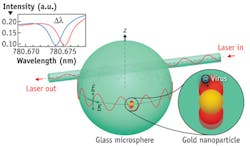DISEASE DETECTION/NANOTECHNOLOGY: Optical fiber-based sensor IDs smallest virus particles
A biosensor able to identify the smallest single virus particles (each just 6 attograms) hopes to revolutionize early disease diagnosis by providing results within minutes at the point of care. The optical fiber-based sensor resulted from efforts to devise a method sensitive enough to detect and size a single virus particle without special assay preparations or conditions.1
Within the device, light from a tunable laser follows a fiber-optic cable capped by a detector that measures its intensity. A small glass sphere, brought into contact with the fiber, diverts the light's path. This change is recorded as a resonant dip in the transmission through the fiber. When a viral particle makes contact with the sphere, it changes the sphere's properties, resulting in a detectable shift in resonance frequency.
Similar methods have proven successful previously for detecting large viruses such as influenza, but smaller particles, such as the polio virus and antibody proteins, require greater sensitivity. Researchers at the MicroParticle PhotoPhysics Laboratory for BioPhotonics (MP3L) at Polytechnic Institute of New York University (NYU-Poly) reached that goal by attaching gold nano-receptors to the resonant microsphere. These receptors are plasmonic, and thus enhance the nearby electric field, making even small disturbances easier to detect. Each gold "hot spot" is treated with specific molecules to which proteins or viruses are attracted.
In experiments, the researchers successfully detected the smallest RNA virus-particle MS2-in solution. They are now working to detect single proteins, which would represent a major step toward early detection of diseases, including cancer. According to Stephen Arnold, professor of applied physics, who led the research, "...if we have a test that can detect a single marker at the protein level, it doesn't get more sensitive than that."
This patent-pending technology, co-authored with postdoctoral fellow Siyka Shopova and graduate student Raaj Rajmangal, is ultimately destined for a point-of-care device capable of detecting viruses or disease markers in blood, saliva, or urine. Testing for commercial applications is already underway.
The researchers call the invention the Whispering Gallery-Mode Biosensor: Like sound in the famous Whispering Gallery at St. Paul's Cathedral in London, light traveling within the glass sphere of the biosensor orbits many times, ensuring nothing on the surface is missed.
1. V. R. Dantham, S. Holler, V. Kolchenko, Z. Wan, and S. Arnold, Appl. Phys. Lett., 101, 043704 (2012).
